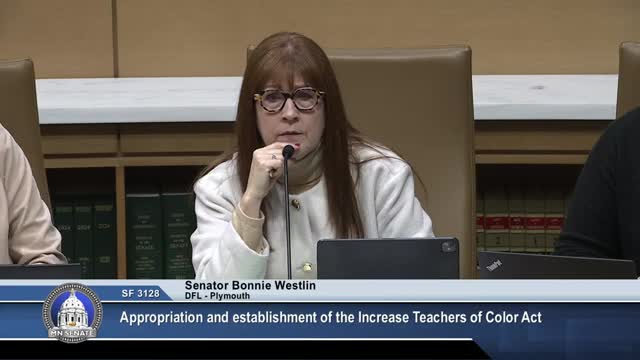Minnesota Senate passes Teachers of Color and American Indian Teachers Act
April 03, 2025 | Education Finance, Senate, Committees, Legislative, Minnesota
Thanks to Scribe from Workplace AI , all articles about Minnesota are free for you to enjoy throughout 2025!

This article was created by AI using a video recording of the meeting. It summarizes the key points discussed, but for full details and context, please refer to the video of the full meeting. Link to Full Meeting
Senator Kunish, a key proponent of the "Teachers of Color and American Indian Teachers Act," emphasized that students benefit significantly from seeing educators who reflect their own backgrounds. "We have students attending our institutions that may rarely see someone who looks like them," she noted, underscoring the impact of role models on both students of color and their white peers. The senator pointed out that the percentage of teachers of color in Minnesota has increased from 3.8% in 2017 to 7.3% today, a change that many believe is essential for fostering an inclusive educational environment.

Before you scroll further...
Get access to the words and decisions of your elected officials for free!
Subscribe for FreeTestifier Mr. Byrd, recognized as Teacher of the Year, echoed these sentiments, sharing how vital it is for all students to see diverse leaders in education. His remarks resonated with committee members, prompting Senator Swadzinski to reflect on the broader implications of representation. "It's not just what they see, but it's also how they learn and the experiences that are taught," he said, recalling his own educational journey and the lack of diversity he encountered.
The meeting also addressed concerns about potential legal challenges to the bill, with some members defending the initiative against claims that it could be unconstitutional. Senator McQuade passionately countered these assertions, stating that addressing historical disparities in education is not only necessary but a moral obligation. "The reason we have such a large racial disparity between teachers of color and white teachers is because of the systematic way we kept people of color out of civil society," she asserted.
As the meeting progressed, the committee members expressed a collective commitment to increasing the number of teachers of color and indigenous educators in Minnesota. They recognized that this effort is not merely about numbers but about enriching the educational experience for all students. Senator Kunish concluded the discussion by reaffirming the importance of investing in diverse educators, stating, "We hope to see that 7.3 grow positively for all of our students."
The meeting highlighted a pivotal moment in Minnesota's educational landscape, as lawmakers and educators alike rallied around the shared goal of fostering a more inclusive and representative teaching workforce. The discussions not only shed light on the current state of education in Minnesota but also set the stage for future initiatives aimed at ensuring that every student has access to role models who reflect the rich diversity of their communities.
Converted from Committee on Education Finance - 04/02/25 meeting on April 03, 2025
Link to Full Meeting
Comments
View full meeting
This article is based on a recent meeting—watch the full video and explore the complete transcript for deeper insights into the discussion.
View full meeting




